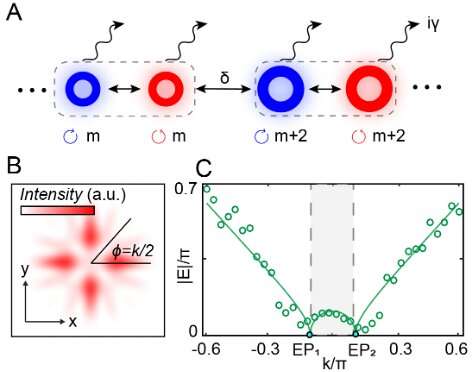This article has been reviewed according to Science X's editorial process and policies. Editors have highlighted the following attributes while ensuring the content's credibility:
fact-checked
peer-reviewed publication
proofread
Researchers realize non-Hermitian exceptional points in degenerate optical cavity

Recently, a research team led by Prof. Guo Guangcan from the University of Science and Technology of China (USTC) constructed a non-Hermiticity (NH) synthetic orbital angular momentum (OAM) dimension in a degenerate optical cavity and observed the exceptional points (EPs). This study was published in Science Advances.
In topological physics, the NH systems depict open systems with complex energy spectra. Exceptional points are one of the unique features of NH systems. To study EPs, the team had constructed synthetic one-dimensional lattices and established topological simulation platform in a degenerate optical cavity. Based on this platform, an additional pseudomomentum was introduced as a parameter to construct the Dirac point in the two-dimensional momentum space. A pair of EPs can be obtained by introducing non-Hermitian perturbation around the Dirac point.
The detection of complex energy spectra in NH systems can be troublesome for traditional means. The research group developed a method which is referred to as wave front angle–resolved band structure spectroscopy to investigate complex energy spectra based on synthetic OAM. Using this method, the team not only detected EPs in momentum space, but also the key features of EPs like bulk Fermi arcs, parity-time symmetry-breaking transition, energy swapping and half-integer band windings.
Compared to traditional topological simulations, the photonic synthetic dimensions demonstrate great flexibility. By tuning the parameter in the synthetic dimension, the team observed a swap of complex energy as the tuned momenta encircling an EP, which directly demonstrated the characteristics of the Riemann surface of the topological energy band.
The simulation platform in the degenerate optical cavity built by the team can be used for the future exploration of topological physics and the development of all-optical devices. The reviewer highly appreciated this work, saying that, "As large non-Hermitian systems are numerically difficult to study, experimental realizations as in the present work could provide new and important insights, especially with respect to technical applications."
More information: Mu Yang et al, Realization of exceptional points along a synthetic orbital angular momentum dimension, Science Advances (2023). DOI: 10.1126/sciadv.abp8943
Journal information: Science Advances
Provided by University of Science and Technology of China





















